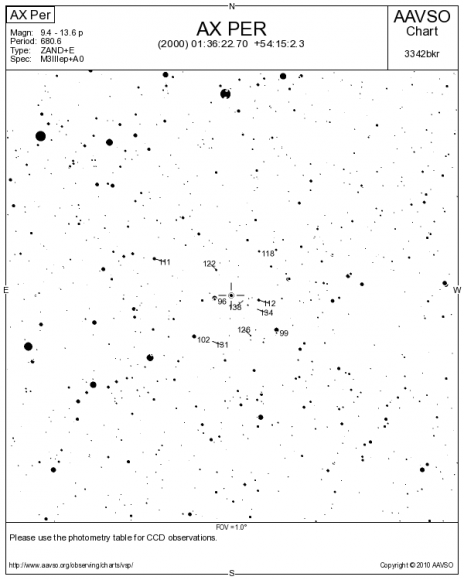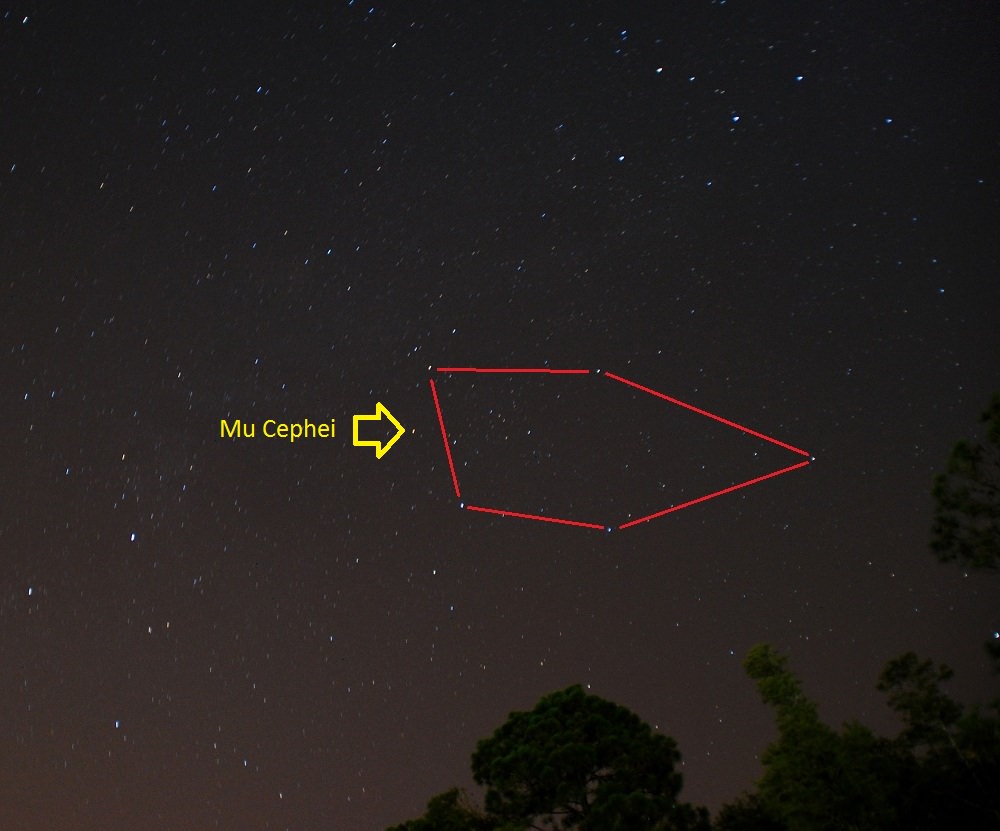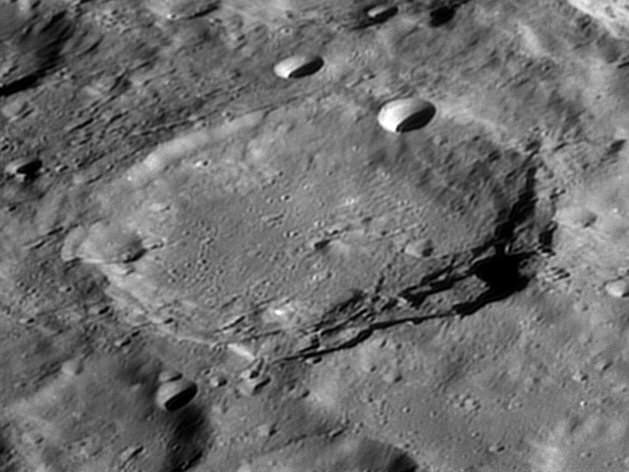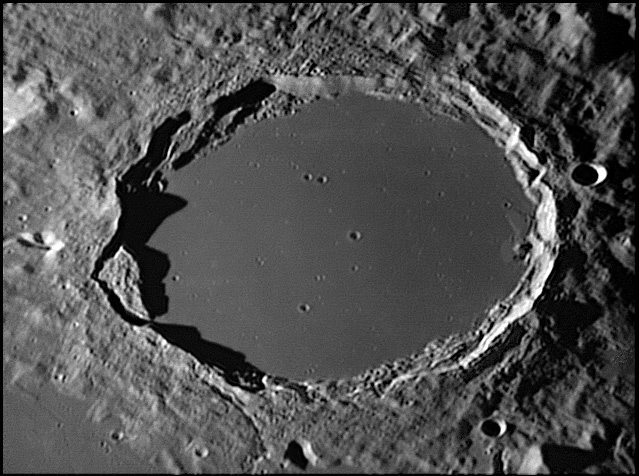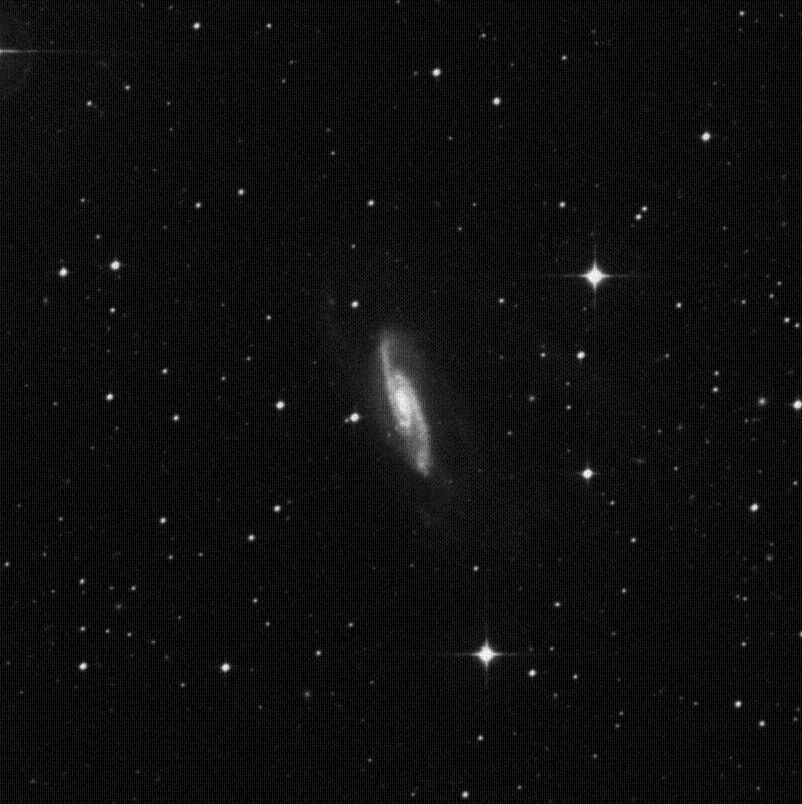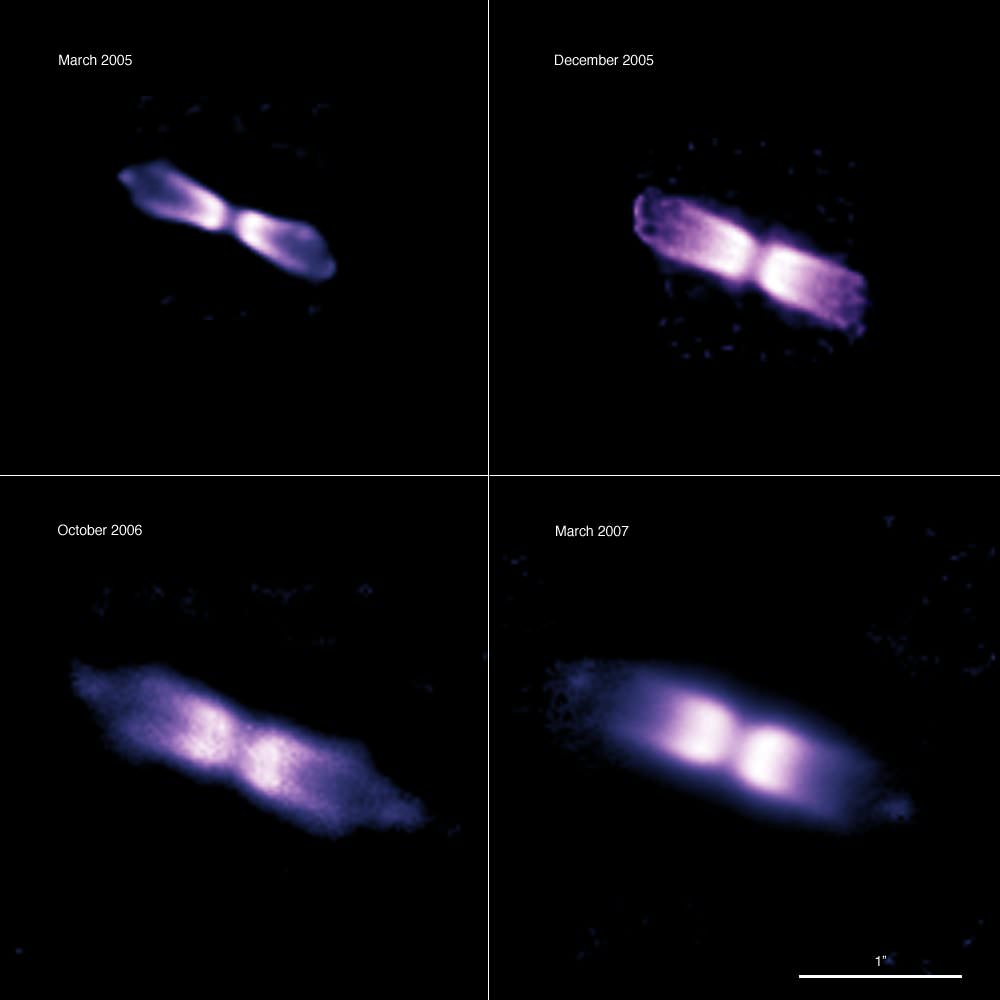There’s a lot you can learn by just staring at an object, watching how it changes in brightness. This is the technique of photometry, and it has helped astronomers discover variable stars, extrasolar planets, minor planets, supernovae, and much more.
Continue reading “Astronomy Cast Ep. 337: Photometry”
Seeing Red: Hunting Herschel’s Garnet Star
Quick, what’s the reddest star visible to the naked eye?
Depending on your sky conditions, your answer may well be this week’s astronomical highlight.
Mu Cephei, also known as Herschel’s Garnet Star, is a ruddy gem in the constellation Cepheus near the Cygnus/Lacerta border. A variable star ranging in brightness by a factor of about three-fold from magnitudes 5.0 to 3.7, Mu Cephei is low to the northeast for mid-northern latitude observers in July at dusk, and will be progressively higher as summer wears on. Continue reading “Seeing Red: Hunting Herschel’s Garnet Star”
What’s Going On Inside This New Kind of Variable Star?
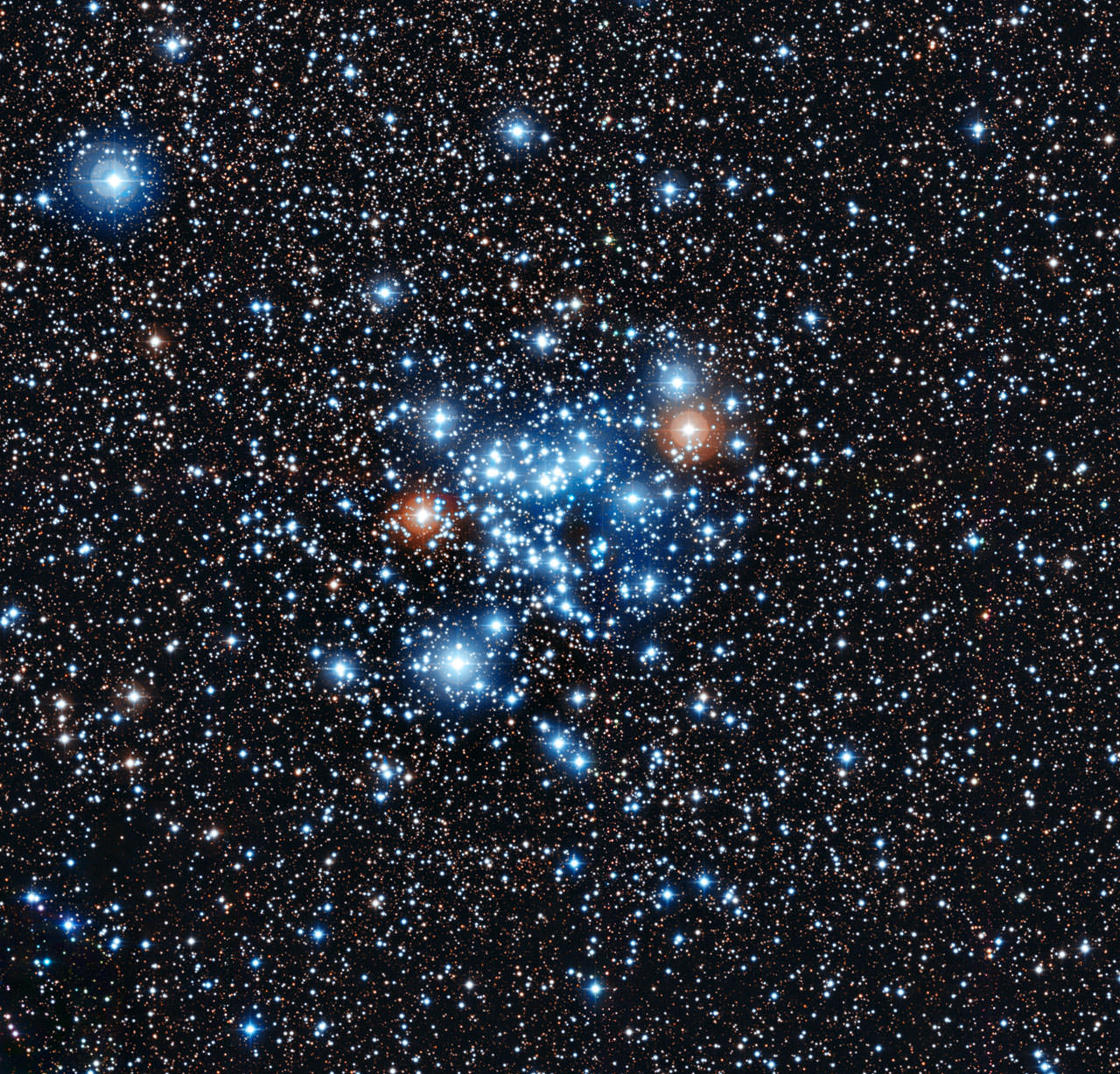
A new kind of variable star — 36 of that type, in fact — has been found in a single star cluster. Astronomers don’t even have a name for the star type yet, but feel free to leave some suggestions in the comments!
For now, however, astronomers are wondering what the implications are for our understanding of the stellar interiors.
“The very existence of this new class of variable stars is a challenge to astrophysicists,” stated Sophie Saesen, an astronomer at Geneva Observatory who participated in the research.
“Current theoretical models predict that their light is not supposed to vary periodically at all, so our current efforts are focused on finding out more about the behaviour of this strange new type of star.”
The head-scratching began when astronomers used a European Southern Observatory telescope to gaze at the “Pearl Cluster” (NGC 3766), an open star cluster about 5,800 light years from Earth.
Over seven years of observations with the Leonhard Euler Telescope (taking periodic measurements of brightness), astronomers spotted 36 stars with variable periods of between 2 and 20 hours.
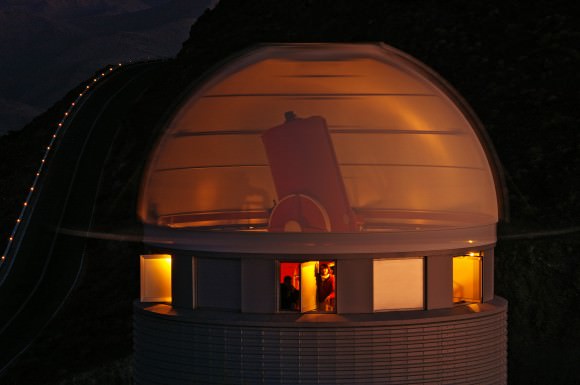
Variable stars have been known for centuries, and many of them are tracked by amateur organizations such as the American Association of Variable Observers. As best as astronomers can figure, the stars become brighter and dimmer due to changes on the inside — stellar vibrations or “quakes” studied under a field called asteroseismology.
A special type of variable stars, called Cepheid variables, can provide accurate measurements of distance since they have an established ratio between luminosity and the period of their variability.
Studying various types of variable stars has provided some insights.
“Asteroseismology of ß Cep[hei] stars, for example, has opened the doors in the past decade to study their interior rotation and convective core,” the astronomers stated in a paper on the research.
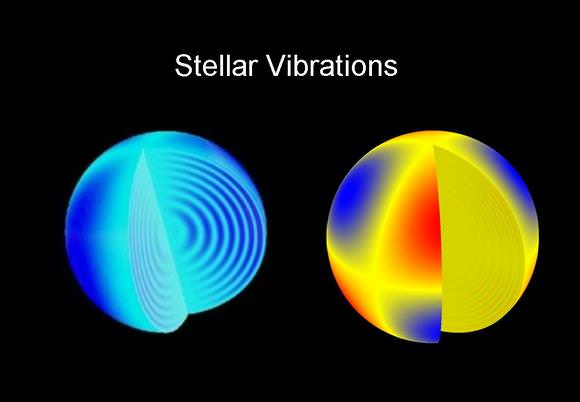
Despite the well-known nature of variable stars, few of them have been studied in open clusters such as NGC 3766.
The reason is it takes a lot of telescope time to take a look at the star — sometimes, years. And time with telescopes is both expensive and precious, making it difficult to allocate the time required.
“Stellar clusters are ideal environments to study stellar variability because some basic properties and the evolutionary status of individual star members can be derived from the properties of the cluster,” the astronomers stated.
“It, however, requires extensive monitoring on an as-long-as-possible time base line. This requirement may explain why not many clusters have been studied for their variability content so far, compared to the number of known and characterized clusters.”
These particular stars in NGC 3766, however, were puzzling.
“The stars are somewhat hotter and brighter than the Sun, but otherwise apparently unremarkable,” ESO stated, yet they had variations of about 0.1% of each star’s normal brightness.
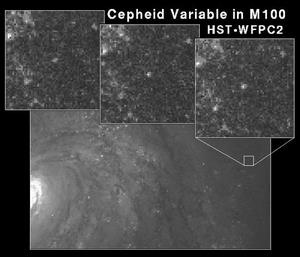
It’s possible, but not proven yet, that perhaps the stars’ spin has something to do with the brightness.
Some of the observed objects whip around at speeds so fast that some material might be punted away from the star and into space, the astronomers wrote in a press release.
“In those conditions, the fast spin will have an important impact on their internal properties, but we are not able yet to adequately model their light variations,” stated Nami Mowlavi, another Geneva Observatory astronomer who led the paper.
Also, astronomers haven’t named this class of stars yet. Do you have any ideas? For more information and to generate suggestions, you can read the paper here in Astronomy & Astrophysics. Then you can leave your thoughts in the comments.
Source: European Southern Observatory
Weekly SkyWatcher’s Forecast: November 19-25, 2012
Greetings, fellow SkyWatchers! It’s going to be a great week to study the Moon – and bright Jupiter is just begging for some quality eyepiece time. Need more? Then why don’t we study some very interesting variable stars, too? It’s all out there… Just waiting on you!
Monday, November 19 – Now we’re ready for some serious lunar study. Our first order of business will be to identify crater Curtius. Directly in the center of the Moon is a dark-floored area known as the Sinus Medii. South of it will be two conspicuously large craters – Hipparchus to the north and ancient Albategnius to the south. Trace along the terminator toward the south until you have almost reached its point (cusp) and you will see a black oval. This normal looking crater with the brilliant west wall is equally ancient crater Curtius. Because of its high southern latitude, we shall never see the entire interior of this crater – and neither has the Sun! It is believed the inner walls are quite steep, and so crater Curtius’ full interior has never been illuminated since its formation billions of years ago. Because it has remained dark, we can speculate there may be “lunar ice” (water ice possibly mixed with regolith) pocketed inside its many cracks and rilles which date back to the Moon’s formation!
Because our Moon has no atmosphere, the entire surface is exposed to the vacuum of space. When sunlit, the surface reaches up to 385 K, so any exposed lunar ice would vaporize and be lost because the Moon’s gravity could not hold it. The only way for ice to exist would be in a permanently shadowed area. Near Curtius is the Moon’s south pole, and imaging from the Clementine spacecraft showed around 15,000 square kilometers of area where such conditions could exist. So where did this ice come from? The lunar surface never ceases to be pelted by meteorites – most of which contain water-related ice. As we know, many craters were formed by just such impacts. Once hidden from the sunlight, this ice could continue to exist for millions of years.
Now turn your eyes or binoculars just west of bright Aldebaran and have a look at the Hyades Star Cluster. While Aldebaran appears to be part of this large, V-shaped group, it is not an actual member. The Hyades cluster is one of the nearest galactic clusters, and it is roughly 130 light-years away in the center. This moving group of stars is drifting slowly away towards Orion, and in another 50 million years it will require a telescope to view!
Tuesday, November 20 – Today celebrates another significant astronomer’s birth – Edwin Hubble. Born 1889, Hubble became the first American astronomer to identify Cepheid variables in M31 – which in turn established the extragalactic nature of the spiral nebulae. Continuing with the work of Carl Wirtz, and using Vesto Slipher’s redshifts, Hubble then could calculate the velocity-distance relation for galaxies. This has become known as “Hubble’s Law” and demonstrates the expansion of our Universe.
Tonight we’re going to ignore the Moon and head just a little more than a fistwidth west of the westernmost bright star in Cassiopeia to have a look at Delta Cephei (RA 22 29 10.27 Dec +58 24 54.7). This is the most famous of all variable stars and the granddaddy of all Cepheids. Discovered in 1784 by John Goodricke, its changes in magnitude are not due to a revolving companion – but rather the pulsations of the star itself.
Ranging over almost a full magnitude in 5 days, 8 hours and 48 minutes precisely, Delta’s changes can easily be followed by comparing it to nearby Zeta and Epsilon. When it is its dimmest, it will brighten rapidly in a period of about 36 hours – yet take 4 days to slowly dim again. Take time out of your busy night to watch Delta change and change again. It’s only 1000 light-years away, and doesn’t even require a telescope! (But even binoculars will show its optical companion.)
Wednesday, November 21 – Before we go star hopping this evening, let’s go south on the lunar globe in hopes of catching a very unusual event. On the southern edge of Mare Nubium is the old walled plain Pitatus. Power up. On the western edge you will see smaller and equally old Hesiodus. Almost central along their shared wall there is a break to watch for when the terminator is close. For a brief moment, sunrise on the Moon will pass through this break creating a beam of light across the crater floor in a beautiful phenomenon known as the “Hesiodus Sunrise Ray.” For a very brief moment, a shaft of sunlight will shine through this break and create an experience you will never forget. If the terminator has moved beyond it at your observing time, then look to the south for small Hesiodus A. This is an example of an extremely rare double concentric crater. This formation is caused by one impact followed by another, slightly smaller impact, at exactly the same location.
Now, let’s continue our stellar studies with the central-most star in the lazy “W” of Cassiopeia – Gamma…
At the beginning of the 20th century, the light from Gamma appeared to be steady, but in the mid-1930s it took an unexpected rise in brightness. In less than 2 years it jumped by a magnitude! Then, just as unexpectedly, it dropped back down again in roughly the same amount of time. A performance it repeated some 40 years later!
Gamma Cassiopeiae isn’t quite a giant and is still fairly young on the evolutionary scale. Spectral studies show violent changes and variations in the star’s structure. After its first recorded episode, it ejected a shell of gas which expanded Gamma’s size by over 200% – yet it doesn’t appear to be a candidate for a nova event. The best estimate now is that Gamma is around 100 light-years away and approaching us at a very slow rate. If conditions are good, you might be able to telescopically pick up its disparate 11th magnitude visual companion, discovered by Burnham in 1888. It shares the same proper motion – but doesn’t orbit this unusual variable star. For those who like a challenge, visit Gamma again on a dark night! Its shell left two bright (and difficult!) nebulae, IC 59 and IC 63, to which we will return at the end of the month.
Thursday, November 22 – Tonight when you’re studying the Moon, return to our landmark Copernicus and travel south along the western shore of Mare Cognitum, the “Sea That Has Become Known” and look along the terminator for the Montes Riphaeus – “The Mountains In The Middle of Nowhere.” But are they really mountains? Let’s take a closer look. At the widest, this unusual range spans about 38 kilometers and runs for a distance of around 177 kilometers. Less impressive than most lunar mountain ranges, some peaks reach up to 1250 meters high, making these summits about the same height as our volcano Mt. Kilauea. While we are considering volcanic activity, consider that these peaks are all that is left of Mare Cognitum’s walls after lava filled it in. At one time this may have been amongst the tallest of lunar features!
Once you’ve studied the Montes Riphaeus, you’ll begin noticing another lunar crater that looks a whole lot like a smaller version of Copernicus – the highly under-rated crater Bullialdus. Located close to the center of Mare Nubium, even binoculars can make out Bullialdus when near the terminator. If you’re scoping – power up – this one is fun! Very similar to Copernicus, Bullialdus’ has thick, terraced walls and a central peak. If you examine the area around it carefully, you can note it is a much newer crater than shallow Lubiniezsky to the north and almost non-existent Kies (a real challenge) to the south. On Bullialdus’ southern flank, it’s easy to make out its A and B craterlets, as well as the interesting little Koenig to the southwest.
Friday, November 23 – Tonight in 1885, the very first photograph of a meteor shower was taken. Also, the weather satellite TIROS II was launched on this day in 1960. Carried to orbit by a three-stage Delta rocket, the “Television Infrared Observation Satellite” was about the size of a barrel, testing experimental television techniques and infrared equipment. Operating for 376 days, Tiros II sent back thousands of pictures of Earth’s cloud cover and was successful in its experiments to control the orientation of the satellite spin and its infrared sensors. Oddly enough, a similar mission – Meteosat 1 – also became the first satellite put into orbit by the European Space Agency, in 1977 on this day. Where is all this leading? Why not try observing satellites on your own! Thanks to wonderful on-line tools from NASA you can be alerted by e-mail whenever a bright satellite makes a pass for your specific area. It’s fun!
When you are ready to sail again, we’ll head to the Moon and cross the the western edge of the second largest lunar sea – Mare Imbrium – as we head northeast for the “lighthouse” points set on either side of the landmark “Bay of Rainbows”. They guard the opening to Sinus Iridum and they have names. The easternmost is Promentorium LaPlace, named for Pierre LaPlace. Little more than 56 kilometers in diameter, it rises above the gray sands some 3019 meters; almost identical in height to Buttermilk Mountain near Aspen. Promontorium Heraclides to the west covers roughly the same area, yet rises to little more than half of LaPlace’s height.
Saturday, November 24 – Tonight grab your telescope and head for the Moon and take another look at a feature you might have missed earlier in the year. ! Look west of very bright punctuation of crater Aristarchus for less prominent crater Herodotus. Just to the north you will see a fine white thread known as Schroter’s Valley. This inconspicuous feature winds its way across the Aristarchus plain for about 160 kilometers and measures about 3 to 8 kilometers wide, and about 1 kilometer deep. Schroter’s Valley is an example of a collapsed lava tube. It may have broken open when lava crossed the surface – or it may have settled downwards when a major meteor strike caused a shock wave. What we are looking at is a long, narrow cave on the surface which is very apparent when the lighting is correct.
Ready to aim for a bullseye? Then head for the bright, reddish star Aldebaran. Set your eyes, scopes or binoculars there and let’s look into the “eye” of the Bull.
Known to the Arabs as Al Dabaran, or “the Follower,” Alpha Tauri took its name for the fact that it appears to follow the Pleiades across the sky. In Latin it was Stella Dominatrix, yet the old English knew it as Oculus Tauri, or very literally the “eye of Taurus.” No matter which source of ancient astronomy lore we explore, there are references to Aldeberan.
As the 13th brightest star in the sky, it almost appears from Earth to be a member of the V-shaped Hyades star cluster, but its association is merely coincidental, since it is about twice as close to us as the cluster. In reality, Aldeberan is on the small end as far as K5 stars go, and like many other orange giants could possibly be a variable. Aldeberan is also known to have five close companions, but they are faint and very difficult to observe with backyard equipment. At a distance of approximately 68 light-years, Alpha is slightly less than 45 times larger than our own Sun and approximately 425 times brighter. Because of its position along the ecliptic, Aldeberan is one of the very few stars of first magnitude that can be occulted by the Moon.
Sunday, November 25 – As the Moon nears Full, it becomes more and more difficult to study, but there are still some features that we can take a look at. Before we go to our binoculars or telescopes, just stop and take a look. Do you see the “Cow Jumping over the Moon”? It is strictly a visual phenomenon—a combination of dark maria which looks like the back, forelegs and hindlegs of the shadow of that mythical animal.
While Cassiopeia is in prime position for most northern observers, let’s return tonight for some additional studies. Starting with Delta, let’s hop to the northeast corner of our “flattened W” and identify 520 light-year distant Epsilon. For larger telescopes only, it will be a challenge to find this 12″ diameter, magnitude 13.5 planetary nebula I.1747 in the same field as magnitude 3.3 Epsilon!
Using both Delta and Epsilon as our “guide stars” let’s draw an imaginary line between the pair extending from southwest to northeast and continue the same distance until you stop at visible Iota. Now go to the eyepiece…
As a quadruple system, Iota will require a telescope and a night of steady seeing to split its three visible components. Approximately 160 light-years away, this challenging system will show little or no color to smaller telescopes, but to large aperture, the primary may appear slightly yellow and the companion stars a faint blue. At high magnification, the 8.2 magnitude “C” star will easily break away from the 4.5 primary, 7.2″ to the east-southeast. But look closely at that primary: hugging in very close (2.3″) to the west-southwest and looking like a bump on its side is the B star!
Dropping back to the lowest of powers, place Iota to the southwest edge of the eyepiece. It’s time to study two incredibly interesting stars that should appear in the same field of view to the northeast. When both of these stars are at their maximum, they are easily the brightest of stars in the field. Their names are SU (southernmost) and RZ (northernmost) Cassiopeiae and both are unique! SU is a pulsing Cepheid variable located about 1000 light-years away and will show a distinctive red coloration. RZ is a rapidly eclipsing binary that can change from magnitude 6.4 to magnitude 7.8 in less than two hours. Wow!
Until next week? Clear skies!
Weekly SkyWatcher’s Forecast: September 24-30, 2012
“Shine on, shine on Harvest Moon… Up in the sky…” Oh! Howdy, fellow SkyWatchers! The seasons are most surely showing their changes in both hemispheres and this week marks the famous “Harvest Moon”. The Moon will very much be in the eyepiece this week, so enjoy some great studies. However, don’t put away your telescopes just yet! Bright skies are a great time to catch up on double star studies and variables. Whenever you’re ready, just meet me in the back yard…
Monday, September 24 – In 1970, the first unmanned, automated return of lunar material to the Earth occurred on this day when the Soviet’s Luna 16 returned with three ounces of the Moon. Its landing site was eastern Mare Fecunditatis. Look just west of the bright patch of Langrenus. Let’s walk upon the Moon this evening as we take a look at sunrise over one of the most often studied and mysterious of all craters – Plato. Located on the northern edge of Mare Imbrium and spanning 95 kilometers in diameter, Class IV Plato is simply a feature that all lunar observers check because of the many reports of unusual happenings. Over the years, mists, flashes of light, areas of brightness and darkness, and the appearance of small craters have become a part of Plato’s lore.
On October 9, 1945 an observer sketched and reported “a minute, but brilliant flash of light” inside the western rim. Lunar Orbiter 4 photos later showed where a new impact may have occurred. While Plato’s interior craterlets average between less than one and up to slightly more than two kilometers in diameter, many times they can be observed – and sometimes they cannot be seen at all under almost identical lighting conditions. No matter how many times you observe this crater, it is ever changing and very worthy of your attention!
Although tonight’s bright skies will make our next target a little difficult to find visually, look around four fingerwidths southwest of Delta Capricorni (RA 21 26 40 Dec -22 24 40) for Zeta. Also known as 34 Capricorni, Zeta is a unique binary system. Located about 398 light-years from Earth, the primary star is a yellow supergiant with some very unusual properties – it’s the warmest, most luminous barium star known. But that’s not all, because the B component is a white dwarf almost identical in size to our own Sun!
Tuesday, September 25 – Tonight would be a great opportunity to take another look at crater Eratosthenes. Just slightly north of lunar center, this easily spotted feature dangles at the end of the Apennine Mountain range like a yo-yo caught on a string. Its rugged walls and central peaks make for excellent viewing. If you look closely at the mountains northeast of Eratosthenes, you will see the high peak of Mons Wolff. Named for the Dutch philosopher and mathematician, this outstanding feature reaches 35 kilometers in height. To the southwest of Era-tosthenes you may also spot the ruined remains of crater Stadius. Very little is left of its walls and the floor is dotted with small strikes. Near the twin pair of punctuations to its south lie the remains of Surveyor 2! Now let’s journey to a very pretty star field as we head toward the western wing tip in Cygnus to have a look at Theta – also known as 13 Cygni. It is a beautiful main sequence star that is also considered by modern catalogs to be a double. For large telescopes, look for a faint (13th magnitude) companion to the west… But it’s also a wonderful optical triple!
Also in the field with Theta to the southeast is the Mira-type variable R Cygni, which ranges in magnitude from around 7 to 14 in slightly less than 430 days. This pulsating red star has a really quite interesting history that can be found at AAVSO, and is circumpolar for far northern observers. Check it out!
Wednesday, September 26 – Tonight on the Moon, let’s take an in-depth look at one of the most impressive of the southern lunar features – Clavius.
Although you cannot help but be drawn visually to this crater, let’s start at the southern limb near the terminator and work our way up. Your first sighting will be the large and shallow dual rings of Casatus with its central crater and Klaproth adjoining it. Further north is Blancanus with its series of very small interior craters, but wait until you see Clavius. Caught on the southeast wall is Rutherford with its central peak and crater Porter on the northeast wall. Look between them for the deep depression labeled D. West of D you will also see three outstanding impacts: C, N and J; while CB resides between D and Porter. The southern and southwest walls are also home to many impacts, and look carefully at the floor for many, many more! It has been often used as a test of a telescope’s resolving power to see just how many more craters you can find inside tremendous old Clavius. Power up and enjoy!
And if you’d like to visit an object that only requires eyes, then look no further than Eta Aquilae one fist-width due south of Altair…
Discovered by Pigot in 1784, this Cepheid-class variable has a precision rate of change of over a magnitude in a period of 7.17644 days. During this time it will reach of maximum of magnitude 3.7 and decline slowly over 5 days to a minimum of 4.5… Yet it only takes two days to brighten again! This period of expansion and contraction makes Eta very unique. To help gauge these changes, compare Eta to Beta on Altair’s same southeast side. When Eta is at maximum, they will be about equal in brightness.
Thursday, September 27 – Tonight exploring the Moon will be in order as one of the most graceful and recognizable lunar features will be prominent – Gassendi. As an ancient mountain-walled plain that sits proudly at the northern edge of Mare Humorum, Gassendi sports a bright ring and a triple central mountain peak that are within the range of binoculars.
Telescopic viewers will appreciate Gassendi at high power in order to see how its southern border has been eroded by lava flow. Also of note are the many rilles and ridges that exist inside the crater and the presence of the younger Gassendi A on the north wall. While viewing the Mare Humorum area, keep in mind that we are looking at an area about the size of the state of Arkansas. It is believed that a planetoid collision originally formed Mare Humorum. The incredible impact crushed the surface layers of the Moon resulting in a concentric “anticline” that can be traced out to twice the size of the original impact area. The floor of this huge crater then filled in with lava, and was once thought to have a greenish appearance but in recent years has more accurately been described as reddish. That’s one mighty big crater!
Tonight we’ll begin with an easy double star and make our way towards a more difficult one. Beautiful, bright and colorful, Beta Cygni is an excellent example of an easily split double star. As the second brightest star in the constellation of Cygnus, Albireo lies roughly in the center of the “Summer Triangle” making it a relatively simple target for even urban telescopes.
Albireo’s primary (or brightest) star is around magnitude 4 and has a striking orangish color. Its secondary (or B) star is slightly fainter at a bit less than magnitude 5, and often appears to most as blue, almost violet. The pair’s wide separation of 34? makes Beta Cygni an easy split for all telescopes at modest power, and even for larger binoculars. At approximately 410 light-years away, this colorful pair shows a visual separation of about 4400 AU, or around 660 billion kilometers. As Burnham noted, “It is worth contemplating, in any case, the fact that at least 55 solar systems could be lined up, edge-to-edge, across the space that separates the components of this famous double!”
Now let’s have a look at Delta. Located around 270 light-years away, Delta is known to be a more difficult binary star. Its duplicity was discovered by F. Struve in 1830, and it is a very tough test for smaller optics. Located no more than 220 AU away from the magnitude 3 parent star, the companion orbits anywhere from 300 to 540 years and is often rated as dim as 8th magnitude. If skies aren’t steady enough to split it tonight, try again! Both Beta and Delta are on many challenge lists.
Friday, September 28 – Tonight our primary lunar study is crater Kepler. Look for it as a bright point, slightly lunar north of center near the terminator. Its home is the Oceanus Procellarum – a sprawling dark mare composed primarily of dark minerals of low reflectivity (albedo) such as iron and magnesium. Bright, young Kepler will display a wonderfully developed ray system. The crater rim is very bright, consisting mostly of a pale rock called anorthosite. The “lines” extending from Kepler are fragments that were splashed out and flung across the lunar surface when the impact occurred. The region is also home to features known as “domes” – seen between the crater and the Carpathian Mountains. So unique is Kepler’s geological formation that it became the first crater mapped by U.S. Geological Survey in 1962.
Up next, we’ll have a look at the central star of the “Northern Cross” – Gamma Cygni. Also known as Sadr, this beautiful main sequence star lies at the northern edge of the “Great Rift.” Surrounded by a field of nebulosity known as IC 1310, second magnitude Gamma is very slowly approaching us, but still maintains an average distance of about 750 light-years. It is here in the rich, starry fields that the great dust cloud begins its stretch toward southern Centaurus – dividing the Milky Way into two streams. The dark region extending north of Gamma towards Deneb is often referred to as the “Northern Coalsack,” but its true designation is Lynds 906.
If you take a very close look at Sadr, you will find it has a well-separated 10th magnitude companion star, which is probably not related – yet in 1876, S. W. Burnham found that it itself is a very close double. Just to its north is NGC 6910 (Right Ascension: 20 : 23.1 – Declination: +40 : 47), a roughly 6th magnitude open cluster which displays a nice concentration in a small telescope. To the west is Collinder 419, another bright gathering that is nicely concentrated. South is Dolidze 43, a widely spaced group with two brighter stars on its southern perimeter. East is Dolidze 10, which is far richer in stars of various magnitudes and contains at least three binary systems.
Whether you use binoculars or telescopes, chances are you won’t see much nebulosity in this region – but the sheer population of stars and objects in this area makes a visit with Sadr worthy of your time!
Saturday, September 29 – Tonight we’re going to have a look at a lunar feature that goes beyond simply incredible – it’s downright weird. Start your journey by identifying Kepler and head due west across Oceanus Procellarum until you encounter the bright ring of crater Reiner. Spanning 30 kilometers, this crater isn’t anything in particular – just shallow-looking walls with a little hummock in the center. But, look further west and a little more north for an anomaly – Reiner Gamma.
Well, it’s bright. It’s slightly eye-shaped. But what exactly is it? Possessing no real elevation or depth above the lunar surface, Reiner Gamma could very well be an extremely young feature caused by a comet. Only three other such features exist – two on the lunar far side and one on Mercury. They are high albedo surface deposits with magnetic properties. Unlike a lunar ray of material ejected from below the surface, Reiner Gamma can be spotted during the daylight hours – when ray systems disappear. And, unlike other lunar formations, it never casts a shadow.
Reiner Gamma also causes a magnetic deviation on a barren world that has no magnetic field. This has many proposed origins, such as solar storms, volcanic gaseous activity, or even seismic waves. But, one of the best explanations for its presence is a cometary strike. It is believed that a split-nucleus comet, or cometary fragments, once impacted the area and the swirl of gases from the high velocity debris may have somehow changed the regolith. On the other hand, ejecta from an impact could have formed around a magnetic “hot spot,” much like a magnet attracts iron filings. No matter which theory is correct, the simple act of viewing Reiner Gamma and realizing that it is different from all other features on the Moon’s earthward facing side makes this journey worth the time!
When you’re done, let’s head about a fingerwidth south of Gamma Cygni to have a look at an open cluster well suited for all optics – M29 (Right Ascension: 20 : 23.9 – Declination: +38 : 3).
Discovered in 1764 by Charles Messier, this type D cluster has an overall brightness of about magnitude 7, but isn’t exactly rich in stars. Hanging out anywhere from 6000 to 7200 light-years away, one would assume this to be a very rich cluster and it may very well have hundreds of stars – but their light is blocked by a dust cloud a thousand times more dense than average. Approaching us at around 28 kilometers per second, this loose grouping could be as old as 10 million years and appears much like a miniature of the constellation of Ursa Major at low powers. Even though it isn’t the most spectacular in star-rich Cygnus, it is another Messier object to add to your list!
Sunday, September 30 – Today in 1880, Henry Draper must have been up very early indeed when he took the first photo of the Great Orion Nebula (M42). Although you might not wish to set up equipment before dawn, you can still use a pair of binoculars to view this awesome nebula! You’ll find Orion high in the southeast for the Northern Hemisphere, and M42 in the center of the “sword” that hangs below its bright “belt” of three stars.
Our seasons are changing – and so the seasons change on other planets, too. Today marks the universal date on which Northern Autumn, Southern Spring Equinox occurs on Mars. Keep an eye for subtle changes in surface features of the red planet!
This is also the Universal date the Moon will become Full and it will be the closest to the Autumnal Equinox. Because its orbit is more nearly parallel to the eastern horizon, it will rise at dusk for the next several nights in a row. On the average, the Moon rises about 50 minutes later each night, but at this time of year it’s around 20 minutes later for mid-northern latitudes and even less farther north. Because of this added light, the name “Harvest Moon” came about because it allowed farmers more time to work in the fields.
Often times we perceive the Harvest Moon as being more orange than at any other time of the year. The reason is not only scientific enough – but true. Coloration is caused by the scattering of the light by particles in our atmosphere. When the Moon is low, like now, we get more of that scattering effect and it truly does appear more orange. The very act of harvesting itself produces more dust and often times that coloration will last the whole night through. And we all know the size is only an “illusion”…
So, instead of cursing the Moon for hiding the deep sky gems tonight, enjoy it for what it is…a wonderful natural phenomenon that doesn’t even require a telescope!
Until next week? Ask for the Moon, but keep on reaching for the stars!
Weekly SkyWatcher’s Forecast: June 18-24, 2012
Greetings, fellow SkyWatchers! Let’s begin the week with some awesome galactic studies and enjoy a meteor shower during Summer Solstice! We’ll be studying variable stars, the planet Mars, Saturn, the Moon and Mercury, too! There’s always a bit of astronomy history and some unusual things to learn about. When you’re ready, just meet me in the back yard…
Monday, June 18 – With dark skies on our side, we’ll spend the next few days concentrating on a very specific region of the night sky. Legend tells us the constellation of Crater is the cup of the gods – cup befitting the god of the skies, Apollo. Who holds this cup, dressed in black? It’s the Raven, Corvus. The tale is a sad one – a story of a creature sent to fetch water for his master, only to tarry too long waiting on a fig to ripen. When he realized his mistake, the sorry Raven returned to Apollo with his cup and brought along the serpent Hydra in his claws as well. Angry, Apollo tossed them into the sky for all eternity and it is in the south they stay until this day.
For the next few days, it will be our pleasure to study the Cup and the Raven. The galaxies I have chosen are done particularly for those of us who still star hop. I will start with a “marker” star that should be easily visible unaided on a night capable of supporting this kind of study. The field stars are quite recognizable in the finder and this is an area that takes some work. Because these galaxies approach magnitude 13, they are best suited to the larger telescope.
Now, let’s go between map and sky and identify both Zeta and Eta Crater and form a triangle. Our mark is directly south of Eta the same distance as between the two stars. At low power, the 12.7 magnitude NGC 3981 (Right Ascension: 11 : 56.1 – Declination: -19 : 54) sits inside a stretched triangle of stars. Upon magnification, an elongated, near edge-on spiral structure with a bright nucleus appears. Patience and aversion makes this “stand up” galaxy appear to have a vague fading at the frontiers with faint extensions. A moment of clarity is all it takes to see tiny star caught at the edge.
Tuesday, June 19 – New Moon! Tonight’s first study object, 12.7 magnitude NGC 3956 (Right Ascension: 11 : 54.0 – Declination: -20 : 34) is about a degree due south of NGC 3981. When first viewed, it appears as edge-on structure at low power. Upon study it takes on the form of a highly inclined spiral. A beautiful multiple star, and a difficult double star also resides with the NGC 3956 – appearing almost to triangulate with it. Aversion brings up a very bright core region which over the course of time and study appears to extend away from the center, giving this very sweet galaxy more structure than can be called from it with one observation.
Our next target is a little more than two degrees further south of our last study. The 12.8 magnitude NGC 3955 (Right Ascension: 11 : 54.0 – Declination: -23 : 10) is a very even, elongated spiral structure requiring a minimum of aversion once the mind and eye “see” its position. Not particularly an impressive galaxy, the NGC 3955 does, however, have a star caught at the edge as well. After several viewings, the best structure I can pull from this one is a slight concentration toward the core.
Now we’ll study an interacting pair and all that is required is that you find 31 Corvii, an unaided eye star west of Gamma and Epsilon Corvii. Now we’re ready to nudge the scope about one degree north. The 11th magnitude NGC 4038/39 (Right Ascension: 12 : 01.9 – Declination: -18 : 52) is a tight, but superior pair of interacting galaxies. Often referred to as either the “Ringtail” or the “Antenna”, this pair deeply captured the public’s imagination when photographed by the Hubble. (Unfortunately, we don’t have the Hubble, but what we have is set of optics and the patience to find them.) At low power the pair presents two very stellar core regions surrounded by a curiously shaped nebulosity. Now, drop the power on it and practice patience – because it’s worth it! When that perfect moment of clarity arrives, we have crackling structure. Unusual, clumpy, odd arms appear at strong aversion. Behind all this is a galactic “sheen” that hints at all the beauty seen in the Hubble photographs. It’s a tight little fellow, but worth every moment it takes to find it.
Return to 31 Corvii and head one half degree northwest to discover 11.6 magnitude NGC 4027 (Right Ascension: 11 : 59.5 – Declination: -19 : 16). Relatively large, and faint at low power, this one also deserves both magnification and attention. Why? Because it rocks! It has a wonderful coma shape with a single, unmistakable bold arm. The bright nucleus seems to almost curl along with this arm shape and during aversion a single stellar point appears at its tip. This one is a real treat!
Wednesday, June 20 – Today marks the official date of 2012 Summer Solstice!
With no Moon to contend with in the predawn hours, we welcome the “shooting stars” as we pass through another portion of the Ophiuchid meteor stream. The radiant for this pass will be nearer Sagittarius and the fall rate varies from 8 to 20, but it can sometimes produce unexpectedly more.
Tonight let’s look to the sky again and fixate on Eta Crater – our study lay one half degree southeast. The 12.8 magnitude NGC 4033 (Right Ascension: 12 : 00.6 – Declination: -17 : 51) is a tough call even for a large scope. Appearing elliptical at low power, it does take on some stretch at magnification. It is smallish, even and quite unremarkable. It requires good aversion and a bit of patience to find. Good luck!
The last of our studies resides by a star, one degree west of Beta Corvii. In order to “see” anything even remotely called structure in NGC 4462 (Right Ascension: 12 : 29.3 – Declination: -23 : 10), this one is a high power only galaxy that is best when the accompanying star is kept out of the field as much as possible. It holds a definite stellar nucleus and a concentration that pulls away from it making it almost appear barred. On an exceptional night with a large scope, wide aversion and moments of clarity show what may be three to four glints inside the structure. Ultra tiny pinholes in another universe? Or perhaps an unimaginably huge, bright globular clusters? While attention is focused on trying to draw out these points, you’ll notice this galaxy’s structure much more clearly. Another true beauty and fitting way to end this particular study field!
Thursday, June 21 – Keep an eye out for the exiting planet Mars! It’s been on the move and has now crossed the border of Virgo and returned to Leo. Have you noticed it quickly changing in both apparent brightness and size? It won’t be long until it’s gone! And speaking of planets on the move, have you spotted Mercury yet? You can find the swift little planet low on the western horizon just after sunset. Look for it just to the south of Castor and Pollux!
For challenging larger telescope studies, return to eastern edge of Mare Crisium and Promontorium Agarum to identify shallow crater Condorcet to its east. Look along the shore of the mare for a mountain to the south known as Mons Usov. Just to its north Luna 24 landed and directly to its west are the remains of Luna 15. We’ll study more about them in the future. Can you spot the tiny dark well of crater Fahrenheit nearby? Continue with your telescope north of Mare Crisium for even more challenging features such as northeast limb studies Mare Smythii and Mare Marginis. Between them you will see the long oval crater Jansky – bordered by Jansky A at the very outer edge.
While you’re out tonight, take a look at the skies for a circlet of seven stars that reside about halfway between orange Arcturus and brilliant blue/white Vega. This quiet constellation is named Corona Borealis – or the “Northern Crown.” Just northwest of its brightest star is a huge concentration of over 400 galaxies that reside over a billion light-years away from us. This area is so small from our point of view that we could cover it with our thumbnail held at arm’s length!
For variable star fans, let’s explore Corona Borealis and focus our attention on S – located just west of Theta – the westernmost star in the constellation’s arc formation. At magnitude 5.3, this long-term variable takes almost a year to go through its changes; usually far outshining the 7th magnitude star to its northeast – but will drop to a barely visible magnitude 14 at minimum. Compare it to the eclipsing binary U Coronae Borealis about a degree northwest. In slightly over three days this Algol-type will range by a full magnitude as its companions draw together.
Friday, June 22 – Today celebrates the founding of the Royal Greenwich Observatory in 1675. That’s 332 years of astronomy! Also on this date in history, in 1978, James Christy of the US Naval Observatory in Flagstaff Arizona discovered Pluto’s satellite Charon.
If you’d like to practice some unaided eye astronomy, then look no further than the western skyline as the Sun sets. At twilight you’ll first notice the very slender crescent Moon – but don’t delay your observations as you can spot Mercury to the west! The inner planet will set very fast, so you’ll need an open horizon. But that’s not all… the speedy little dude is lined up perfectly with Castor and Pollux! With the foursome nearly “in a row” this will make a very cool apparition to remind friends and family to watch for!
Now, grab your favorite optics for a selenographic treat tonight return to the area just north of Mare Crisium area to observe spectacular crater Cleomides. This two million year old crater is separated from Crisium by some 60 kilometers of mountainous terrain. Telescopically, Cleomides is a true delight at high power. To Cleomides’ east, begin by identifying Delmotte, and to the northwest, Trailes and Debes. About twice Clemoides’ width northwest, you will see a sharply well-defined Class I crater Geminus. Named for the Greek astronomer and mathematician Geminos, this 86 kilometer wide crater shows a smooth floor and displays a long, low dune across its middle.
When you’re finished, point your binoculars or telescopes back towards Corona Borealis and about three fingerwidths northwest of Alpha for variable star R (Ra 15. 48.6 Dec +28 09). This star is a total enigma. Discovered in 1795, most of the time R carries a magnitude near 6, but can drop to magnitude 14 in a matter of weeks – only to unexpectedly brighten again! It is believed that R emits a carbon cloud which blocks its light. When studied at minima, the light curve resembles a “reverse nova,” and has a peculiar spectrum. It is very possible this ancient Population II star has used all of its hydrogen fuel and is now fusing helium to carbon. It’s so odd that science can’t even directly determine its distance!
Saturday, June 23 – If you missed yesterday’s apparition of Mercury, then try again tonight. While the small planet might be dim, just look for the brighter pairing of Castor and Pollux above the western horizon at twilight. Can’t find it? Then try this. When you look at this famous pair of stars, judge the distance between the two. Now, apply that same distance and angle to the left (southern) star, Pollux, and you’ve found Mercury! Need more? Then check out the Moon and you’ll see Regulus is about a fistwidth to the east/southeast and Mars is a little more than two handspans to the southeast. Still more? Then continue on from Mars southeast about about another two handspans and you’ll see the pairing of Spica and Saturn!
Using your telescope tonight on the Moon will call up previous study craters, Atlas and Hercules to the lunar north. If you walk along the terminator to the due west of Atlas and Hercules, you’ll see the punctuation of 40 kilometer wide Burg just emerging from the shadows. While it doesn’t appear to be a grand crater just yet, it has a redeeming feature – it’s deep – real deep. If Burg were filled with water here on Earth, it would require a deep submergence vehicle like ALVIN to reach its 3680 meter floor! This class II crater stands nearly alone on an expanse of lunarscape known as Lacus Mortis. If the terminator has advanced enough at your time of viewing, you may be able to see this walled-plain’s western boundary peeking out of the shadows.
While we’re out, let’s have a look at Delta Serpens. To the eye and binoculars, 4th magnitude Delta is a widely separated visual double star… But power up in the telescope to have a look at a wonderfully difficult binary. Divided by no more than 4 arc seconds, 210 light-year distant Delta and its 5th magnitude companion could be as old as 800 million years and on the verge of becoming evolved giants. Separated by about 9 times the distance of Pluto from our Sun, the white primary is a Delta Scuti-type variable which changes subtly in less than four hours. Although it takes the pair 3200 years to orbit each other, you’ll find Delta Serpens to be an excellent challenge for your optics.
Sunday, June 24 – On this day in 1881, Sir William Huggins made the first photographic spectrum of a comet (1881 III) and discovered cyanogen (CN) emission at violet wavelengths. Unfortunately, his discovery caused public panic around 29 years later when Earth passed through the tail of Halley’s Comet. What a shame the public didn’t realize that cyanogens are also released organically! More than fearing what is in a comet’s tail, they should have been thinking about what might happen should a comet strike. Tonight look at the wasted Southern Highland area of the Moon with new eyes… Many of these craters you see were caused by impacts – some as large as the nucleus of Halley itself.
Now let’s pick up a binocular curiosity located on the northeast shore of Mare Serenitatis. Re-identify the bright ring of Posidonius, which contains several equally bright points both around and within it – and look at Mare Crisium and get a feel for its size. A little more than one Crisium’s length west of Posidonius you’ll meet Aristotle and Eudoxus. Drop a similar length south and you will be at the tiny, bright crater Linne on the expanse of Mare Serenitatis. So what’s so cool about this little white dot? With only binoculars you are resolving a crater that is one mile wide, in a seven mile wide patch of bright ejecta – from close to 400,000 kilometers away! While you were there, did you notice how much Proclus has changed tonight? It is now a bright circle and beginning to show bright lunar rays…
Before we head for deep sky, be sure to at least take a look at Saturn and Mars. Right now the Ring King has reached its greatest westward position and will begin its tour back to the east. Now, check out Mars’ position to the west and measure with your hands roughly how far apart they are. At this point they are separated by about two handspans. Check again in a few weeks to see planetary motion displayed right before your eyes!
Now let’s turn binoculars or telescopes towards magnitude 2.7 Alpha Librae – the second brightest star in the celestial “Scales.” Its proper name is Zuben El Genubi, and even as “Star Wars” as that sounds, the “Southern Claw” is actually quite close to home at a distance of only 65 light-years. No matter what size optics you are using, you’ll easily see Alpha’s 5th magnitude companion widely spaced and sharing the same proper motion. Alpha itself is a spectroscopic binary which was verified during an occultation event, and its inseparable companion is only a half magnitude dimmer according to the light curves. Enjoy this easy pair tonight!
Until next week? Ask for the Moon… But keep on reaching for the stars!
STEREO Looks at the Sun; Finds Planets
[/caption]
The primary mission of the twin STEREO probes is to explore the 3-dimensional makeup of our Sun. Each craft carries a variety of instruments. One of them, the Heliospheric Imager (HI), doesn’t look directly at the Sun, but rather, explores a wide field near the Sun in order to explore the physics of coronal mass ejections (CMEs), in particular, ones aimed at the Earth. But while not focusing on solar ejections, the HI is free to make many other observations, including its first detection of an extrasolar planet.
As the Heliospheric Imager stares at the space between the Earth and Sun, it has made many novel observations. The device first opened its shutters in 2006 the instrument has observed the interaction of CMEs with the atmosphere of Venus, the stripping of a tail of a comet by a CME, atomic iron in a comet’s tail, and “the very faint optical emission associated with so-called Corotating Interaction Regions (CIRs) in interplanetary space, where fast-flowing Solar wind catches up with slower wind regions.”
The spacecraft allows for long periods of time to stare at patches of sky as the satellites precede and follow Earth in its orbit. The spacecraft is able to take pictures roughly every 40 minutes for almost 20 days in a row giving excellent coverage. As a result, the images taken have the potential to be used for detailed survey studies. Such information is useful for conducting variable star studies and a recent summary of findings from the mission reported the detection of 263 eclipsing variable stars, 122 of which were not previously classified as such.
Another type of variable star observed by the STEREO HI, was the cataclysmic sort, in particular, V 471 Tau. This red giant/white dwarf binary in the Hyades star cluster is a strong source of interest for stellar astrophysicists because the system is suspected to be a strong candidate for a type Ia supernova as the red giant dumps mass onto its high mass, white dwarf companion. The star system is extremely erratic in its light output and observations could help astronomers understand how such systems evolve.
Although planetary hunting is at the very edge of the capabilities of the HI’s limitations, eclipses caused by planet sized objects are feasible for many of the brighter stars in the field of view as dim as approximately 8th magnitude. Around one star, HD 213597, the STEREO team reported the detection of an object that seems too small to be a star based on the light curve alone. However, follow up studies will be necessary to pin down the object’s mass more accurately.
20 Million Observations by Amateur Astronomers!
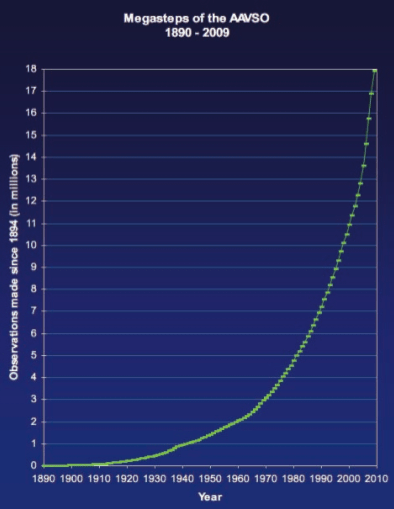
[/caption]Early into the celebration of its centennial year, observers of the American Association of Variable Star Observers (AAVSO) passed another milestone over the weekend, when an amateur astronomer from Belgium contributed the 20 millionth observation of a variable star on February 19, 2011.
Amateur astronomers have been recording changes in the brightness of stars for centuries. The world’s largest database is run by the AAVSO. Started in 1911, it is one of the oldest, continuously operating citizen science projects in the world.
“The long-term study of stellar brightness variation is critical to understanding how stars work and the impact they have on their surroundings. The noble efforts of the engaged AAVSO volunteers play an important role in astronomy and help expand human knowledge,” said Dr. Kevin Marvel, Executive Officer of the American Astronomical Society.
The AAVSO currently receives variable star brightness estimates from about 1,000 amateur astronomers per year. Some variable stars are bright enough to be seen with the unaided eye while others require high-tech equipment. The AAVSO also has a network of robotic telescopes available to members free of charge.
“Because some variable stars are unpredictable and/or change their brightness over long time scales, it is not practical for professional astronomers to watch them every night. Thus, amateurs were recruited to keep tabs on these stars on behalf of professionals,” Dr. Arne Henden, Director of the AAVSO, said.
The 20 millionth observation was made by Dr. Franz-Josef “Josch” Hambsch of Belgium. The observation was of GV Andromeda, member of a class of older, pulsating stars smaller than our Sun. “I like these stars because you can see their entire variation cycle in one night. There have not been many recent observations made of this particular star, so that is why I am monitoring it,” Hambsch said. Hambsch is also a member of the Belgian variable star organization, Vereniging Voor Sterrenkunde, Werkgroep Veranderlijke Sterren (VVS, WVS).
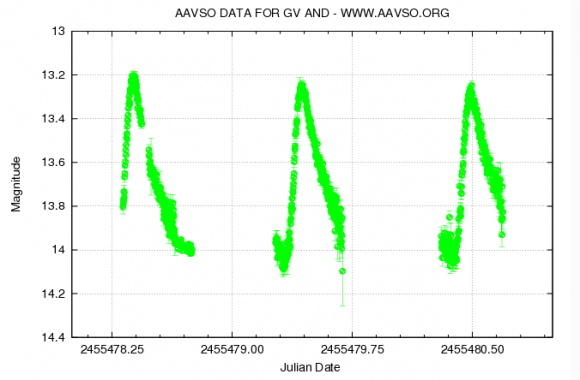
The process of estimating a star’s brightness can range from less than a minute to many hours per estimate, but typically takes about five minutes. At that rate, observers have invested the equivalent of about 1.67 million hours of time in collecting observations for the database. Assuming a current median salary of US$33,000, this would be the roughly equivalent to 27.5 million dollars worth of donated time if all the observations were reported today.
“The reality is these observations are invaluable. The database spans many generations and includes data that cannot be reproduced elsewhere. If an astronomer wants to know the history of a particular star, they come to the AAVSO,” Henden said.
The AAVSO’s mission is to coordinate, collect, and distribute variable star data to support scientific research and education. The AAVSO International Database is openly available to the public through their web site (www.aavso.org), where it is queried hundreds of times per day.
Will V445 Puppis Become a Ia Supernova?
As the “V” in the designation of V445 Puppis indicates, this star was a variable star located in the constellation of Puppis. It was a fairly ordinary periodic variable, although with a rather complex light curve, but still showing a distinct periodicity of about fifteen and a half hours. It wasn’t especially bright, yet something seemed to tug at my memory regarding the star’s name as I scanned through articles to write on. Just over a year ago, Nancy wrote a post on V445 Puppis stating it’s a supernova just waiting to happen. A new article challenges this claim.
In December of 2000, V445 Puppis underwent an unusual nova. It was first noticed on December 30th, but archival records showed the eruption began in early November of that year and reached a peak brightness on November 29th. The system was known to be a binary star system with a shared envelope in which the primary star was a white dwarf and thus, a nova was the most readily available explanation.
However, this wasn’t a normal nova. Spectroscopic observations early the next year showed the ejecta lacked the helium emission seen in classical novae in which hydrogen piles up on a white dwarf surface until it undergoes fusion into helium. Instead, astronomers saw lines of iron, calcium, carbon, sodium, and oxygen expanding at nearly 1,000 km/sec. This fit better with a proposed type of explosion where, instead of hydrogen collecting on the dwarf’s surface, it was helium and the eruption seen was a helium flash in which it was helium that underwent fusion. Slowly the star faded, and debris from the eruption cooled to form dust. Today, the star itself is completely obscured in the visible portion of the spectrum.
The 2009 paper by Woudt, Steeghs, and Karowska that Nancy cited, suggested accretion might continue until the white dwarf passed the Chandrasekhar limit and exploded as a type Ia supernova. However, the authors of the new paper, led by V. P. Goranskij at Moscow University, say that this 2000 detonation has effectively ruled out that possibility because an explosion of that magnitude would likely destroy the envelope of the donor star. Their evidence for this is the very same structure Woudt noted in his paper (shown above).
While the structure looks to be bipolar in nature, other observations have suggested that there is an additional component along the line of sight and that the structure is more of a doughnut shape. In this case, the total amount of material lost is higher than originally anticipated and must have come from from the envelope of the companion star. Additionally, observations in wavelengths able to pierce the dust have been unable to resolve a strong stellar source which suggests that the donor star’s envelope has been largely blown away as well. Additionally, this large and rapid loss of mass from the system may have broken the gravitational bond between the two stars and allowed the giant star to be ejected from the system, which would also preclude the possibility of a supernova in the future.
The conclusion is that V445 Puppis is not a candidate for a supernova of any type in the future. It’s own premature fireworks have likely destroyed whatever chance it may have had for an even grander show in the future.
Symbiotic Variable Star On the Verge of an Eruption?
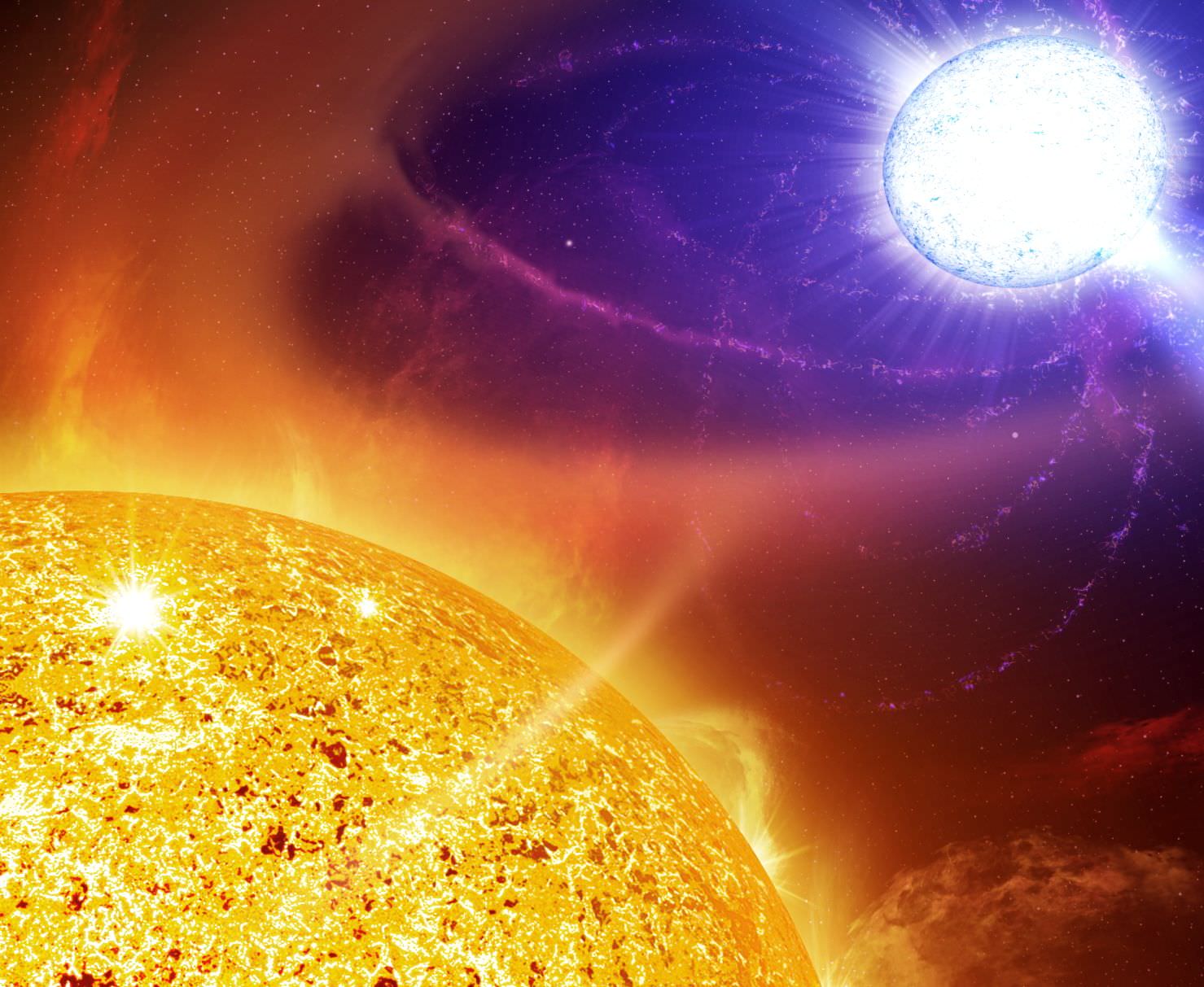
[/caption]
November 23rd, astronomers from the Asiago Novae and Symbiotic Stars collaboration announced recent changes in the symbiotic variable star, AX Persei, could indicate the onset of a rare eruption of this system. The last major eruption took place between 1988 and1992. In the (northern hemisphere) spring of 2009, AX Per underwent a short outburst that was the first time since 1992 this star had experienced a bright phase. Now AX Per is on the rise again. This has tempted astronomers to speculate that another major eruption could be in the making.
Symbiotic variable stars are binary systems whose members are a hot compact white dwarf in a wide orbit around a cool giant star. The orbital periods of symbiotic variables are between 100 and 2000 days. Unlike dwarf novae, compact binaries whose periods are measured in hours, where mass is transferred directly via an accretion disk around the white dwarf, siphoned directly from the surface of the secondary, in symbiotic variables the pair orbit each other far enough away that the mass exchanged between them comes from the strong stellar wind blowing off the red giant. Both stars reside within a shared cloud of gas and dust called a common envelope.
When astronomers look at the spectra of these systems they see a very complex picture. They see the spectra of a hot compact object superimposed on the spectra of a cool giant star tangled up with the spectrum of the common envelope. The term “symbiotic” was coined in 1941 to describe stars with this combined spectrum.
Typically, these systems will remain quiescent or undergo slow, irregular changes in brightness for years at a time. Only occasionally do they undergo large outbursts of several magnitudes. These outbursts are believed to be caused either by abrupt changes in the accretion flow of gas onto the primary, or by the onset of thermonuclear burning of the material piled up on the surface of the white dwarf. Whatever the cause, these major eruptions are rare and unpredictable.
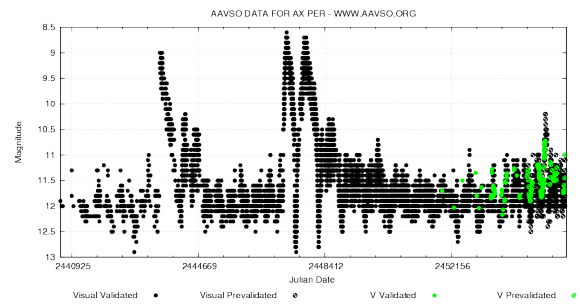
AX Per underwent a short-duration flare about one year before the onset of the major 1988-1992 outburst. Now astronomers are tempted to speculate. Could the 2009 short outburst be a similar precursor type event? The present rise in brightness by AX Per might be the onset of a major outburst event similar to that in 1988-1992. The watch begins now, and professional and amateur variable star observers will be keeping a close eye on AX Per in the coming months.
Ranging from 8.5 to 13th magnitude, AX Persei is visible to anyone with an 8-inch telescope, and if it erupts to maximum it will be visible in binoculars. You can monitor this interesting star and report your observations to the American Association of Variable Star Observers (AAVSO). Charts with comparison stars of known brightness can be plotted and printed using the AAVSO’s Variable Star Chart Plotter, VSP.
